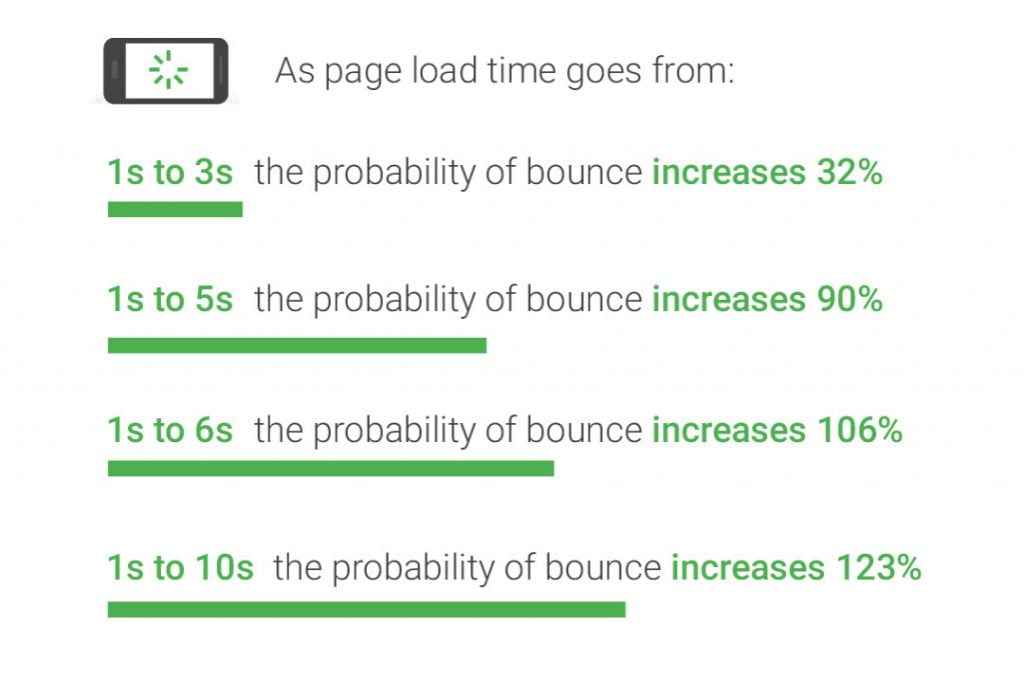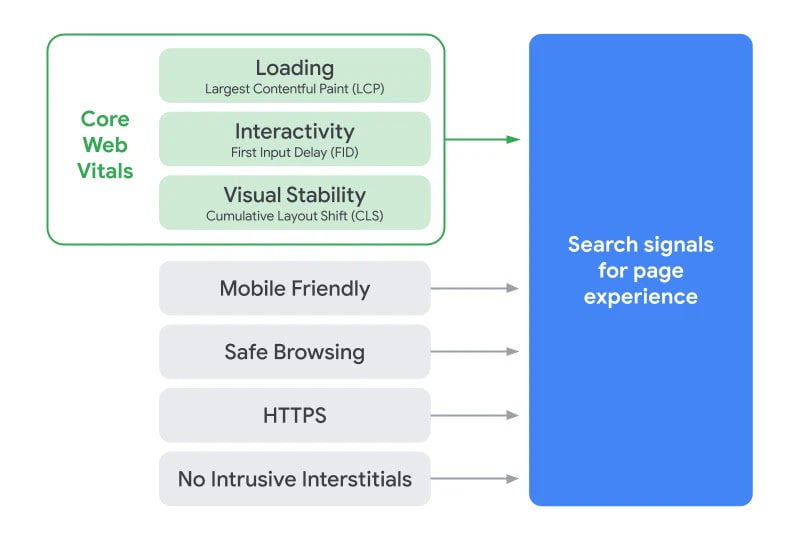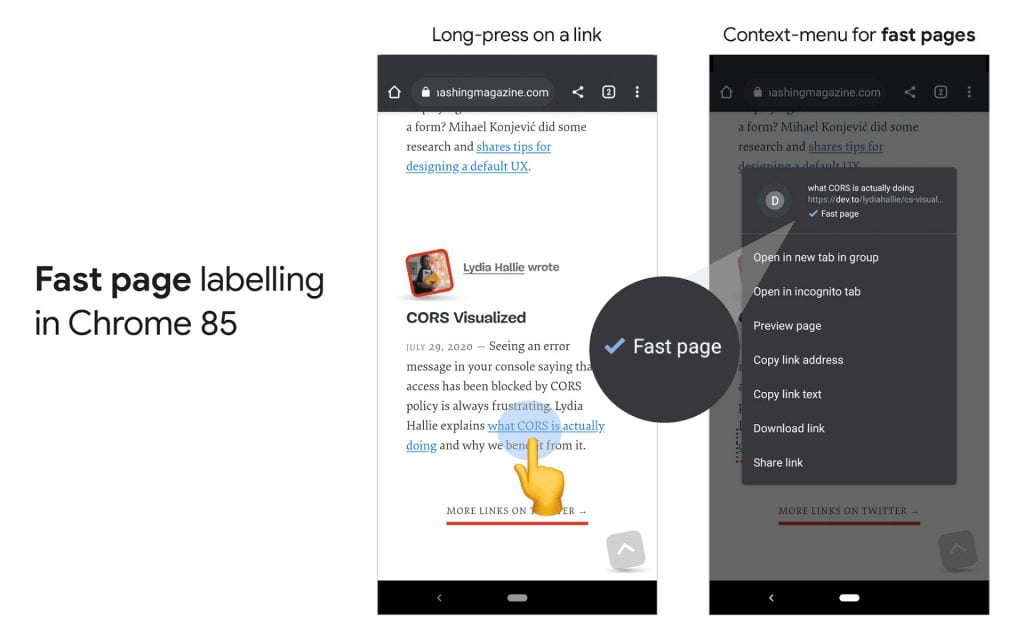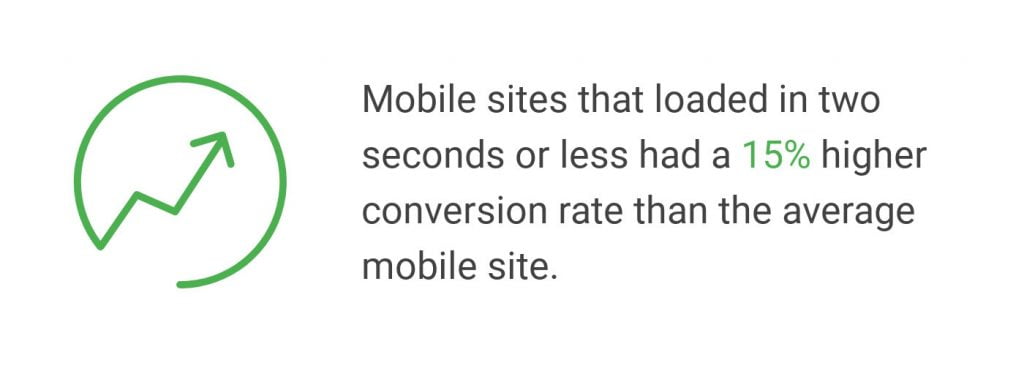The main reason why website speed is important is that website visitors are very fast at leaving websites that take over a second to load. Visitors expect websites to load very fast and they are ready to leave fast if your website doesn’t load even faster. It is either your website or them, your choice.
There are plenty of websites on the internet where they can go. So, why would they spend their time waiting for your site to load when they can just go to another website?
If that seems too much, here is a fact from Google.

Yes, you saw that right, 53 percent of visitors will abandon your site if it takes over 3 seconds to load.
Now, do you know the average website speed? Google tells us that as well.

On average, webpages take more than 15 seconds to load on mobile devices considering that mobiles are now being predominantly used to access the internet. So, most sites are surely getting victims of this load speed trap.
Why Website Speed Is Important?
No one likes a slow website. That’s the biggest reason why website speed is so important. From acquiring new website visitors to converting them into recurring paid customers, website speed plays an important role. The research on this is very clear.
Here are some of the reasons why website speed is so important.
1. Website Speed Affects Search Ranking
Search engines use many ranking factors for showing any webpage in their search results. And website speed is considered as one of those factors. That’s why website speed is now an important component of SEO. Search Engine Optimization (SEO) is the process of making your website more likable to the search engines so that your site ranks higher in search results.
Google uses website speed as one of the ranking factors for desktop searches from 2010 and for mobile searches from 2018. So, it is important to have faster loading website in order to appear higher in google search rankings.
Though we don’t know how much weight Google gives to website speed as a ranking factor, we can guess it is not negligible. That is because Google takes a lot of initiatives into making the web faster (this has been described in the later section in this article).
We can see how website speed correlates to Google search ranking from a research by Neil Patel. The research found that the first five positions in the search results had noticeably faster load time than the others. Moreover, the 6th ranked results were, on average, 20 percent slower than the 1st ranked ones.

The research also found that Google search ranking had the most significant correlation with the TTFB speed. TTFB (Time to First Byte) is one of the metrics that are used to measure different stages of a page load time. It measures the time it takes for web browsers to receive the first bit of data from the web server.

As you can see in the chart, TTFB is significantly faster for the first ranked ones. And therefore it should be seriously taken into consideration while optimizing your site for speed.
Of course, Google cares most about ranking websites with the best information but it also cares about what happens after the visitors click a search result. After all, both of them are ultimately related to improving user experience. And that’s why the importance of website speed is considerably high in SEO.
2. Website Speed Affects Bounce Rate
Bounce rate defines the percentage of people that leave your website without taking any action like filling out a form, making a purchase, and so on. In other words, it means when someone visits a single page on your site and then leaves without clicking any links, buttons, or anything else that takes them to another page on your site.
There can be many reasons behind the bounces. For instance, the visitors got what they were looking for from the first page, they couldn’t find relevant information, poor quality of the website contents, and many others. And one of the major reasons for the bounces is slow loading speed. In fact, slow loading speed often makes visitors leave even before any website contents appear on their screen.
Website speed has a very high impact on the bounce rate. In fact, according to Google, if a webpage takes 3 seconds to load, it will have a bounce rate probability of 32 percent. And by 5 seconds the bounce rate will be 90 percent and by 10 seconds it will be 123 percent.

You ask how the bounce rate can be above 100 percent. It can be under many circumstances. For instance, you may configure your analytics provider like Google Analytics not to count page views from you. This way your page views will not be counted but the bounces may still be counted. So, you get 0 page view but 1 bounce whenever you visit any webpage on your site.
As per a research by Section, page load time has a significant impact on how many pages people visit per session. They found that, at 2 seconds load time, people visit 8.9 pages on average per session. And as the load time goes up people visit less and less number of pages in per visit. Then by 8 seconds load time, they visit only 3.3 pages on average.

Here, the number of page visits per session decreases by 63 percent when load time goes from 2 seconds to 8 seconds. That is about a 10 percent decrease on average for every second. And the biggest decrease being 25 percent when the page speed goes from 2 seconds to 3 seconds.
If your website requires people to visit more than one page, then a low bounce rate is very important. For instance, if your site is an online store then people will need to go through the product page, cart page, checkout page, and others in order to buy something. Additionally, if you want your visitors to keep on reading multiple articles on your site or browse through multiple pages like the home page, services page, contact page, and so on, then a low bounce rate is also crucial. And this is the case or most websites.
You take a lot of time and spend a lot of money on getting people to your site. So, it only makes sense that you want your site visitors to keep visiting your site. They land on one page of your site, then go to another then another, and so on. Even better, if you are running an online store, the more time they spend on your site, the more likely they will order your products or services. If you run ads on your site, then more page visits will earn you more ad revenue. So, a low bounce rate is a very desirable and can be one of the most important things for your website. And a fast website speed can help with that.
3. Website Speed Affects Return Visit
Website speed influences how your current visitors behave on your site. But it doesn’t stop there. In fact, it influences whether they will come back to your website or not.
For instance, as Google puts it, 62 percent of people are less likely to purchase from a site in the future if they have a negative experience on mobiles. And because loading speed is an important element in the user’s experience, a substantial percentage of the people will tend not to come back to your site only because of slow website speed.

4. Website Speed Affects Conversion Rate
Conversion rate is probably the most important thing that website owners care about. That’s because It is directly related to how much they can earn from their website. And the relation between loading speed and conversion rate is pretty striking.
According to Google, every second increase in website load time decreases your conversion rate by up to 20 percent. That’s a whooping rate considering that average websites take 15 seconds to fully load on mobile devices.

The data is even more striking for many industries where every millisecond gets significant. For instance, Google found that a decrease of just 0.1 seconds in website load time increases conversion rate by 8.4 percent for retail stores and 10.1 percent for travel sites. Yes, it says every one-tenth of a second, you read that right. Additionally, it contributes to an increased average order value of 9.2 percent for retail stores and an increased page view per session by 8 percent for luxury sites.

5. Website Speed Affects User Experience
Website speed is all about the user experience of the visitors. The better their experience will be, the more they will want to be with your website. Maybe by staying on your site longer at each session or by coming back to your site more often or by purchasing more from your site or by doing something else. Whatever it is, website speed is surely a determinant of customer satisfaction and consequently website success.
To describe how important loading speed is, a study by Ericsson ConsumerLab can be useful. The study found that delays in loading web pages and delays in videos under time pressure cause mobile user’s heart rate to rise by 38 percent on average. Delays in video streaming of 6 seconds cause stress levels to rise by a third. And that level of stress is equivalent to the anxiety of watching a horror movie alone or taking a math test.

As you can see, fast website speed is a must in order to keep your visitors happy and stress-free. So, you decide how you want your website visitors to feel about your site.
6. Website Speed Affects Bottom Line
So far it was about generalizations. Now let’s see some examples of how website speed has improved the bottom line of many companies.
- Google saw 20% decrease in traffic and revenue for 0.5 seconds increase in load speed
- Amazon saw 1% decrease in revenue for every additional 0.1 second increase in load time
- Walmart saw 2% increase in conversion rate for every additional second decrease in load time and 1% increase in revenue for every additional 0.1 second decrease in load time
- Pinterest saw 15% increase in search engine traffic and sign ups after reducing perceived page speed by 40%.
- AliExpress saw 10.5% increase in orders and 27% increase in conversion rate after reducing load time by 36%
- BBC saw 10% loss of users for every additional second increase in load time
- Telegraph saw 11% decrease in page views after intentionally increasing load time to 4 seconds and the number went up from there as they increased the load time and by 20 seconds they saw 44% decrease in page views
- COOK saw 7% increase in conversion rate, 10% increase in page visits per session, and 7% decrease in bounce rate after reducing page load time by only 0.85 seconds
- Furniture Village saw 10% increase in conversion rate after reducing 20% load time
- The Trainline saw £8 million increase in revenue after reducing load time by 0.3 seconds
- Zitmaxx Wonen saw 50.2% increase in conversion rate and 98.7% increase in revenue from mobiles after reducing load time to 3 seconds
- Carousell saw 63% increase in organic traffic, 3 times increase in advertising click through rate, and 46% increase in first time chatters after reducing load time by 65%
- Missguided saw 26% increase in revenue after reducing load time by 4 seconds
- AutoAnything saw 12% to 13% increase in sales after reducing load time by half
These are just a few of the many that have substantially benefitted by just increasing their website speed. And these results were all possible only because of the better user experience that was made possible by improved page speed.
Website Speed on Mobile Is More Important
Mobiles are now being used more than desktops to access internet internationally. And the rate is on the rise. As per StatCounter, currently, mobiles have 52.31 percent and desktops have 47.69 percent market share without considering other devices like tablets.

This trend of the increasing number of mobile devices makes it very important to emphasize more on mobiles than desktops while optimizing websites. However, the loading speed on mobiles is significantly slower for most websites.
In fact, as per HTTP Archive, average webpage load time on desktops is now 6.7 seconds where it is 18.9 seconds for mobiles. This makes webpages 182 percent slower in mobiles compared to desktops. In the following website load time trend chart, onLoad means total load time.

As you can see, the average loading time on mobiles is significantly slower than desktops and it has been so for years. Now that the number of internet users from mobile devices is the highest and still growing, it is crucial to improve website speed for mobiles more than ever.
According to a research by Google, even though over half of all web traffic comes from mobiles, the conversion rates from mobiles are lower than desktops. And the reason is the slow loading speed on mobiles.
Google has already adopted mobile first indexing because majority of their searches are now from mobile devices. That means webpages are now crawled using a smartphone Googlebot and so mobile friendliness is a major ranking factor. That is to say, page speed on mobile devices is now more important than on desktop devices for SEO (Search Engine Optimization).
Google Stands for Fast Website Speed
Google already uses website speed as a ranking factor so they surely want websites to be faster. But there is more to it than that. Over the years they have taken many initiatives towards making the web faster. To get a general view of their initiatives, take a look at this timeline from Unbounce (modified to add the latest information).

Some of these important initiatives taken by Google towards making the web faster are described below:
Core Web Vitals
Core web vitals is used by Google as a metrics for user experience and it is based mostly on website speed. The purpose of core web vitals is to identify the loading speed, responsiveness, and visual stability of webpages so that website owners can improve their websites for better user experience.
It has already been integrated into the page experience signals by Google. Page experience is used to measure the user experience of webpages. And starting in May 2021, Page experience will become a search ranking factor. This will require websites to load super in order to pass the core web vitals test and ultimately to rank higher in search engines.

AMP (Accelerated Mobile Pages)
AMP is an open source HTML framework originally created by Google to help webpages load faster on mobile devices. It is now supported by many others like Microsoft Bing and Twitter.
AMP is similar to Facebook Instant Articles which helps websites load faster from Facebook.
When there is an AMP version of a webpage, Google will store that version in their CDN for faster delivery of that page from all over the world. Then they will use that stored version in their mobile search results. Therefore, whenever someone clicks on that webpage from the mobile search result, the page will load significantly faster.
As an initiative to pushing it to more websites, Google made AMP a ranking criteria for top stories in mobile search results. However, this criteria is now being removed and replaced by page experience metrics.
Speed Badging
Google has already started rolling out features in chrome browser that labels fast loading webpages as “Fast page”. This feature will be available if you have turned on “Lite mode” or “Make Searches and Browsing Better” on the chrome browser on your android. Long pressing on any link on chrome opens a popup where you will see this label.

Labeling like this will have impact on the the behavior of website visitors. Therefore, visitors will be more likely to open a website if it is labeled as fast.
This is just the beginning of Google’s plan of speed badging. So, we can expect to see this trend continue. Google will implement more of this type of labeling in order to help improve user experience.

All these efforts of Google translate into one thing very clearly that they care about site speed and so prioritizes fast loading websites whenever possible.
What Is a Good Website Load Speed?
As discussed earlier, there are many benefits of fast page speed. But as it appears so most websites don’t have a good loading speed. And the speed in mobile devices are especially poor.
Though average load time is much better in desktops at 6.7 seconds as opposed to 18.9 seconds for mobile as per HTTP Archive, it is still far from being standard. And this significantly longer average load time is making most websites severely underperform from every perspective like search ranking, bounce rate, conversion rate, and so on. Therefore, by improving just the page speed, most sites can be benefitted almost immediately. But for that, it is necessary to have a good load time target.
Website load time under 2 seconds can be a very good standard to uphold.
According to a study from 2011, 47 percent of people expect their website to load under 2 seconds. That’s almost half of the people so their expectation should be important. Besides, this 2 second limit has also been found to be important from other criteria. For instance, Google found that mobile sites with 2 seconds or less loading time have 15 percent higher conversion rate than average mobile sites.

Then when the load time goes to 3 seconds, bounce rates start to become significant like 32 percent bounce rate for 3 seconds load time, 90 percent for 5 seconds and so on.
Additionally, customer satisfaction starts to noticeably lower from 3 seconds. As per a research by Unbounce, almost 50 percent of the surveyed people said that they tried to refresh a webpage at least once if it doesn’t load in 3 seconds. Moreover, 22 percent of them said that they will close the webpage and 14 percent said they will go to a competitor’s site at that point. So, the impact of even slower load speed will surely cause even poorer consequences.
That’s why page load time of under 2 seconds is very much desirable where 3 seconds can be the upper limit for a well optimized website.
How Do I Test My Website Speed?
In order to test your website speed for both desktop and mobile devices, you can use a webpage speed testing website like dotcom-tools.

It will give you options to select browser type where you will get to select browser type as well as device type. So, you will be able to test using both desktop and mobile devices. Additionally, you will get to select multiple locations around the world from where you want to do the testing.
After you do the testing by entering your webpage address, it will tell you how many seconds that webpage took to load from the selected locations. In fact, it will give you load time for first visit and repeat visit from all these locations and the average load time for both the visits.
Now, based on the results, you will be able to see if your website loads fast enough or if it needs any improvements.